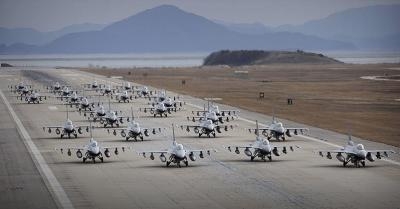Thu, Apr 11, 2013
Implementing A 'Tiered Readiness Concept' For Active-Duty Units
Air Force officials began to stand down active-duty combat units April 9 to ensure the remaining units supporting worldwide operations can maintain sufficient readiness through the remainder of the fiscal year. The stand down is the result of cuts to Air Combat Command's operations and maintenance account, which must be implemented in part by flying approximately 45,000 fewer training hours between now and Oct 1.

As the Air Force's lead for Combat Air Forces, ACC manages the flying-hour programs for four major commands. This decision to stand down or curtail operations affects about one-third of the active-duty CAF aircraft -- including those assigned to fighter, bomber, aggressor and airborne warning and control squadrons -- stationed in the U.S., Europe and the Pacific. "We must implement a tiered readiness concept where only the units preparing to deploy in support of major operations like Afghanistan are fully mission capable," said Gen. Mike Hostage, the ACC commander. "Units will stand down on a rotating basis so our limited resources can be focused on fulfilling critical missions."
"Historically, the Air Force has not operated under a tiered readiness construct because of the need to respond to any crisis within a matter of hours or days," Hostage said. "The current situation means we're accepting the risk that combat airpower may not be ready to respond immediately to new contingencies as they occur."
Some units currently deployed -- including A-10 Thunderbolt IIs, B-1 Lancers, F-16 Fighting Falcons and F-22 Raptors -- will stand down after they return from their deployments. The remaining units will stand down operations on April 9. Active-duty aircrews assigned to Air Force Reserve or Air National Guard A-10 or F-16 squadrons under an arrangement known as "active associations" will also stop flying. The stand down will remain in effect for the remainder of fiscal 2013 barring any changes to current levels of funding. "We're entering uncharted territory in terms of how we've had to take this year's cuts and make adjustments to mitigate the most serious impacts," Hostage said. "Remaining as mission-ready as possible for combatant commanders is our priority, and we're prioritizing spending to ensure this imperative is met."
Units that are stood down will shift their emphasis to ground training. They will use flight simulators to the extent possible within existing contracts, and conduct academic training to maintain basic skills and knowledge of their aircraft. As funding allows, aircrews will also complete formal ground training courses, conduct non-flying exercises and improve local flying-related programs and guidance. Maintainers will complete upgrade training and clear up backlogs of scheduled inspections and maintenance as possible given budget impacts in other areas, such as stock of spare parts.
Although each weapon system is unique, on average aircrews lose currency to fly combat missions within 90 to 120 days of not flying. It generally takes 60 to 90 days to conduct the training needed to return aircrews to mission-ready status, and the time and cost associated with that retraining increases the longer that crews stay on the ground. "This will have a significant and multiyear impact on our operational readiness," Hostage said. "But right now, there is no other acceptable way to implement these cuts."
(Image provided by the USAF)
More News
DETRESFA (Distress Phrase) The code word used to designate an emergency phase wherein there is reasonable certainty that an aircraft and its occupants are threatened by grave and i>[...]
Aero Linx: The International Association of Missionary Aviation (IAMA) The International Association of Missionary Aviation (IAMA) is comprised of Mission organizations, flight sch>[...]
Also: EP Systems' Battery, Boeing SAF, Repeat TBM 960 Order, Japan Coast Guard H225 Buy Despite nearly 100 complaints totaling millions of dollars of potential fraud, combined with>[...]
Also: Viasat-uAvionix, UL94 Fuel Investigation, AF Materiel Command, NTSB Safety Alert Norges Luftsportforbund chose Aura Aero's little 2-seater in electric trim for their next gli>[...]
Also: Moya Delivery Drone, USMC Drone Pilot, Inversion RAY Reentry Vehicle, RapidFlight UAVOS has recently achieved a significant milestone in public safety and emergency services >[...]
 ANN's Daily Aero-Term (04.26.24): DETRESFA (Distress Phrase)
ANN's Daily Aero-Term (04.26.24): DETRESFA (Distress Phrase) ANN's Daily Aero-Linx (04.26.24)
ANN's Daily Aero-Linx (04.26.24) Airborne 04.22.24: Rotor X Worsens, Airport Fees 4 FNB?, USMC Drone Pilot
Airborne 04.22.24: Rotor X Worsens, Airport Fees 4 FNB?, USMC Drone Pilot Airborne 04.24.24: INTEGRAL E, Elixir USA, M700 RVSM
Airborne 04.24.24: INTEGRAL E, Elixir USA, M700 RVSM Airborne-NextGen 04.23.24: UAVOS UVH 170, magni650 Engine, World eVTOL Directory
Airborne-NextGen 04.23.24: UAVOS UVH 170, magni650 Engine, World eVTOL Directory



